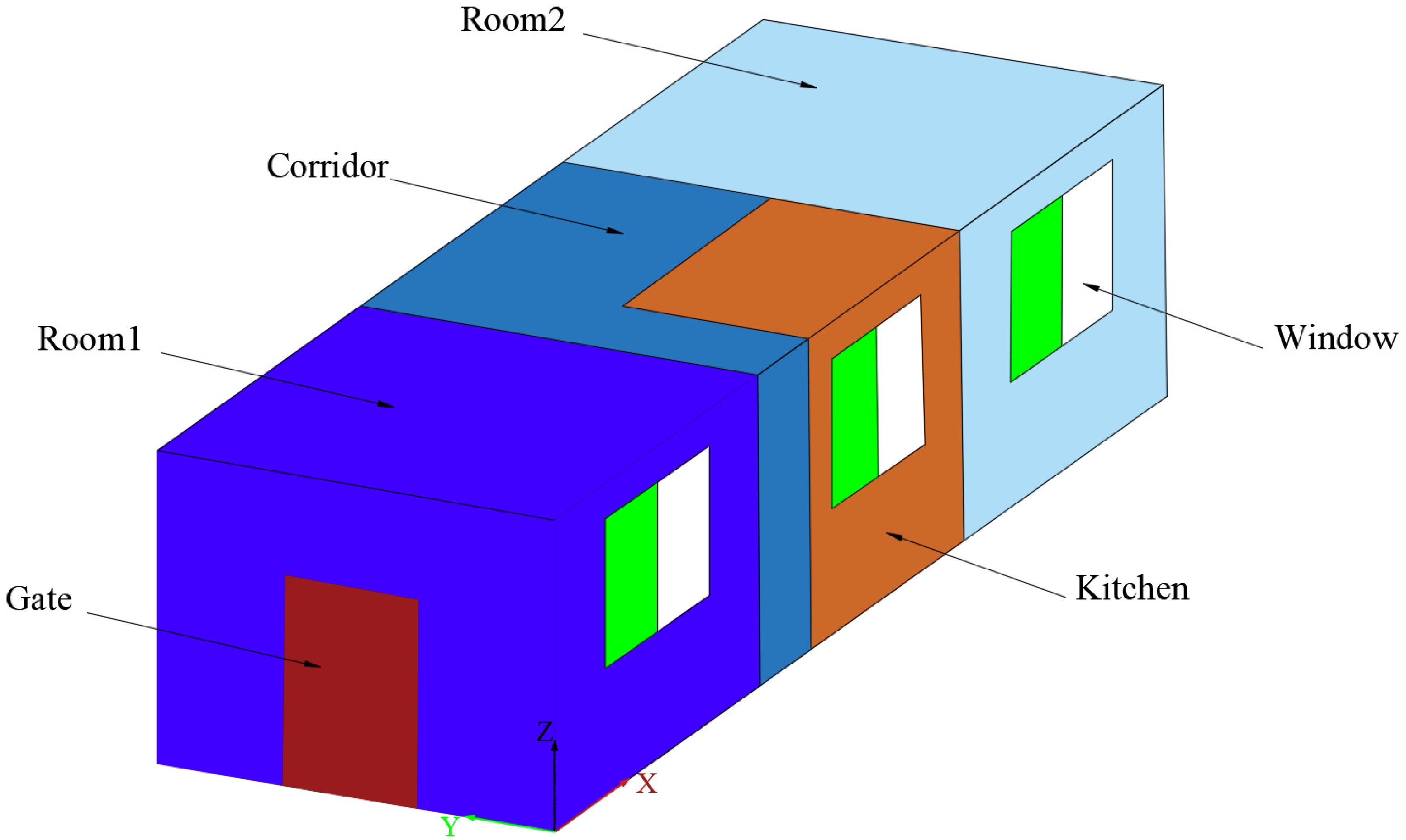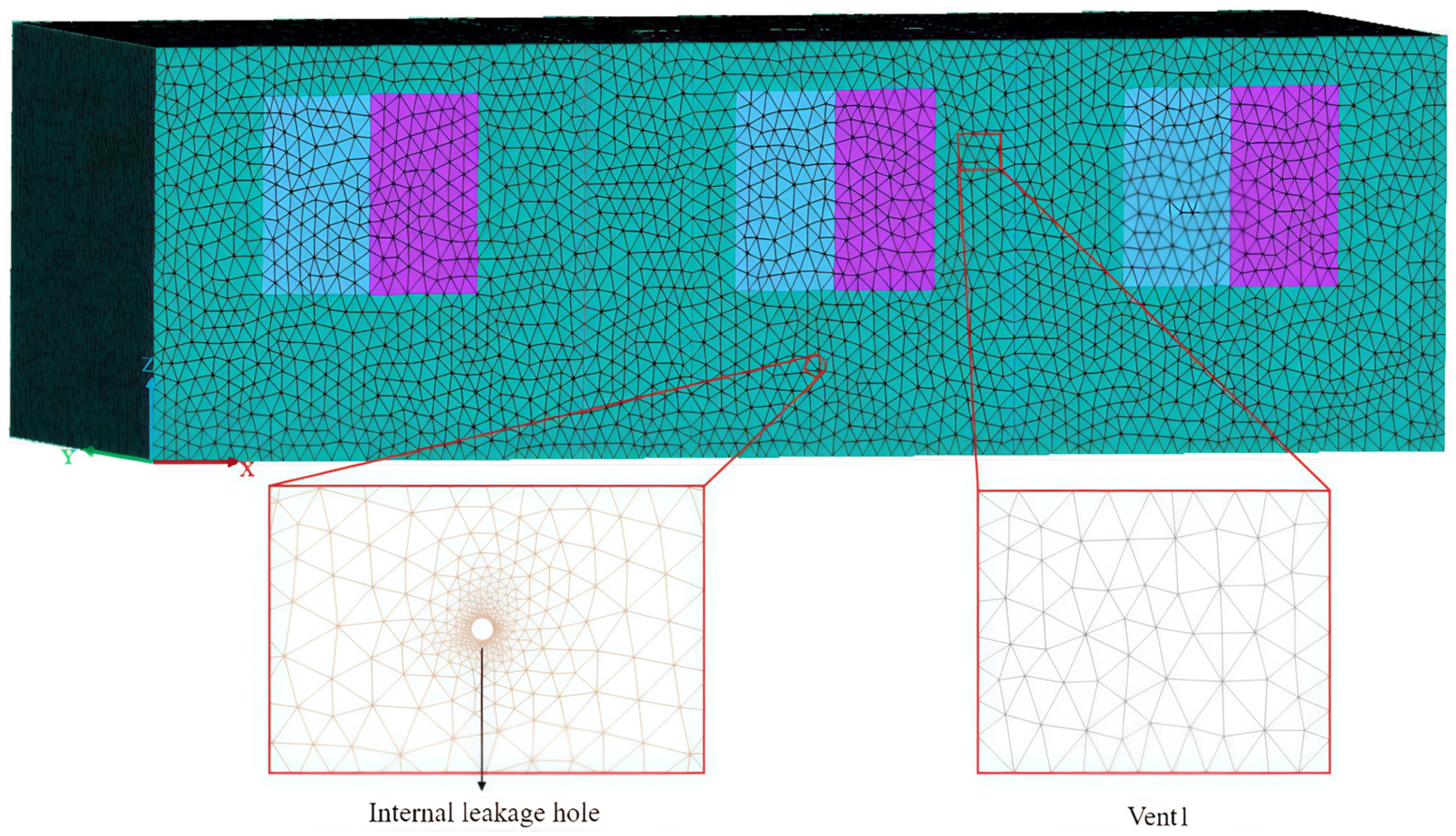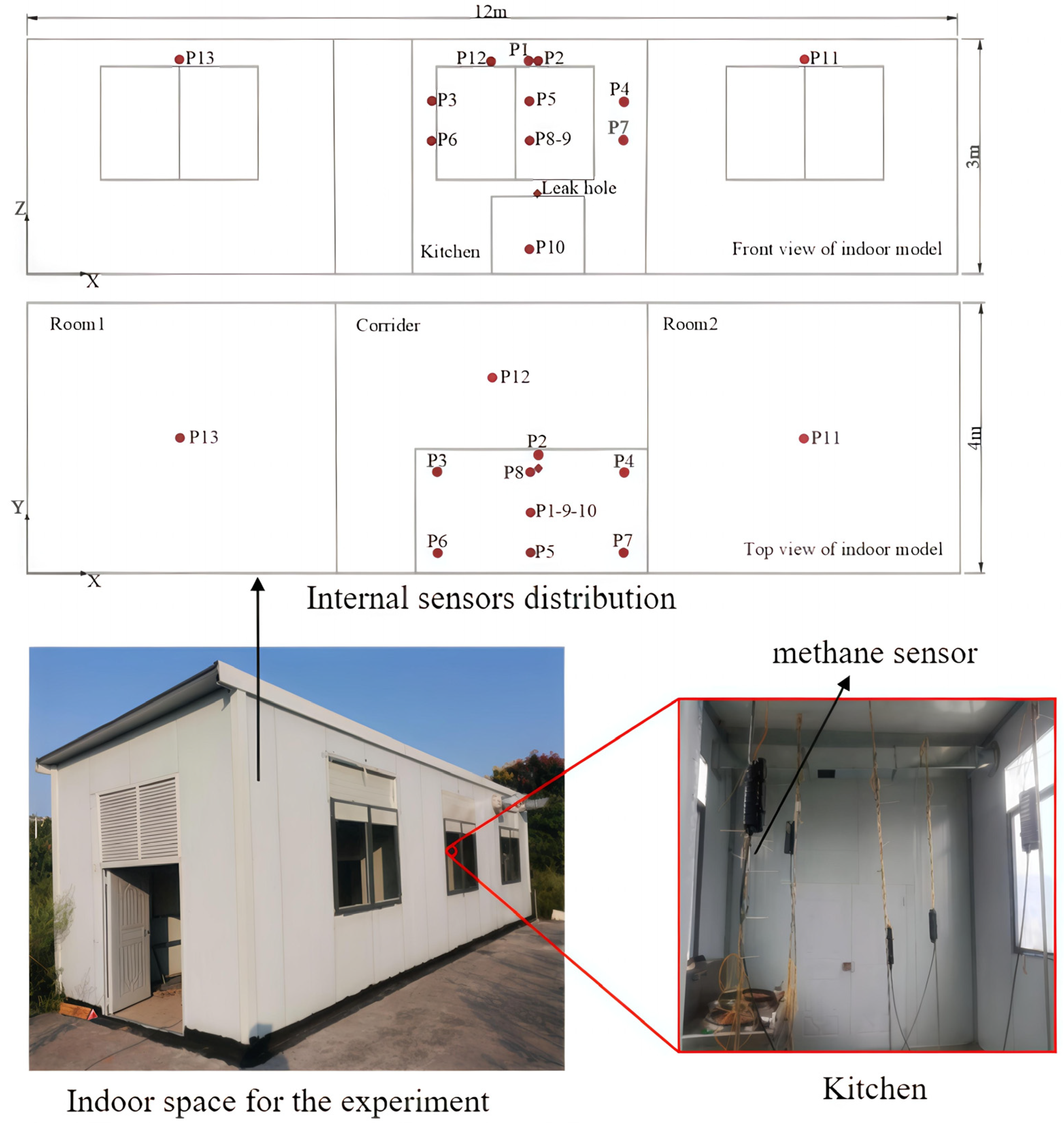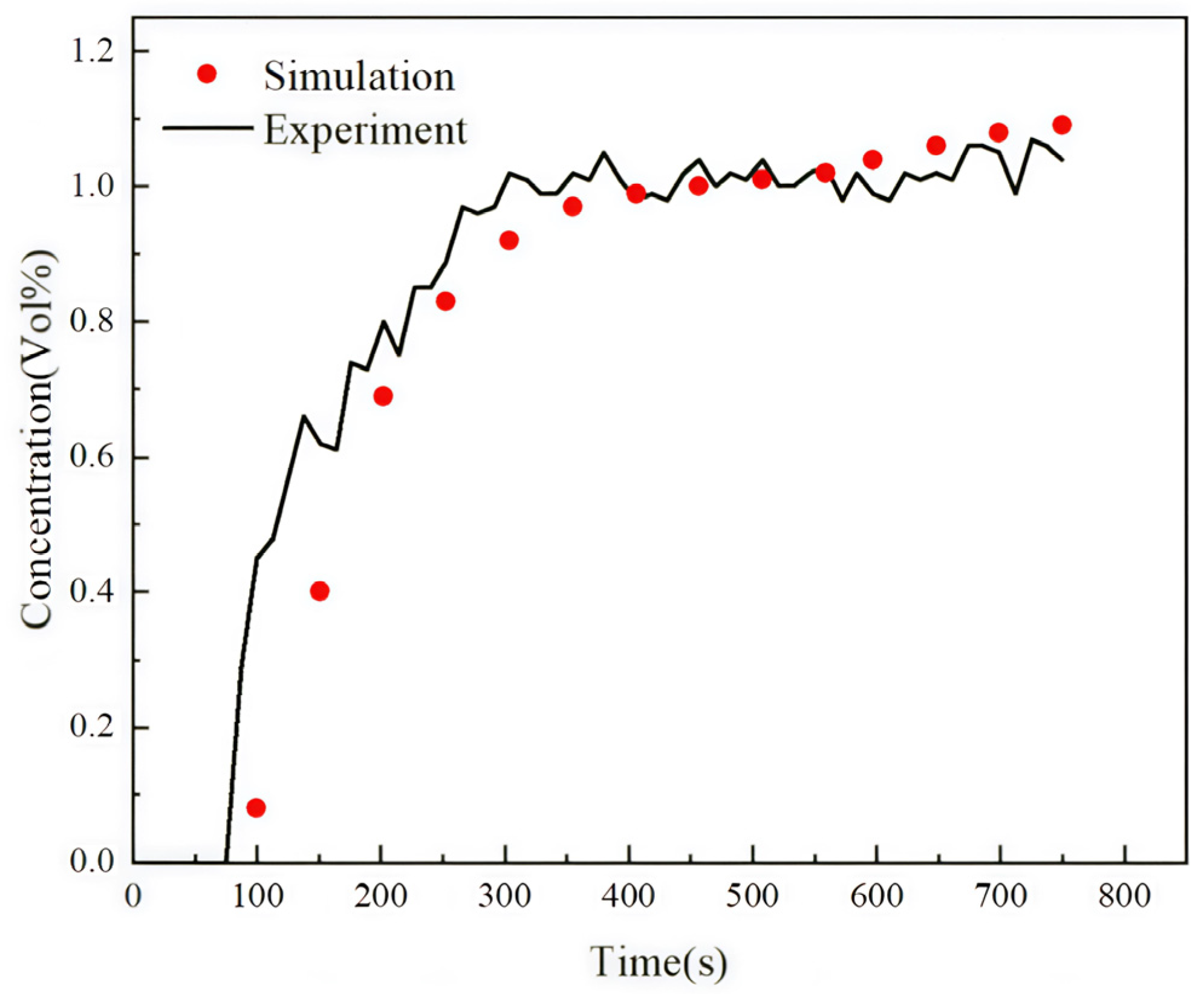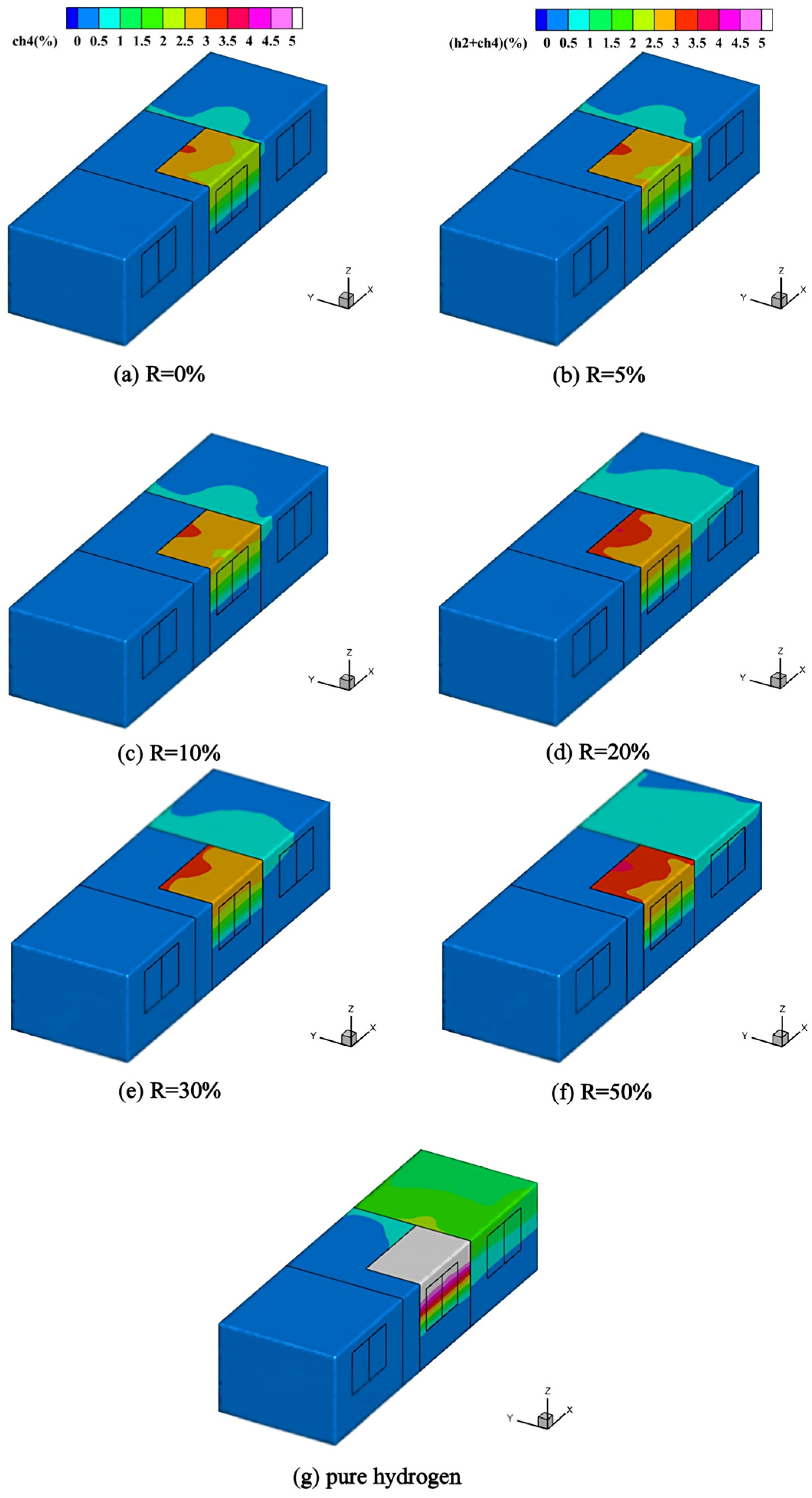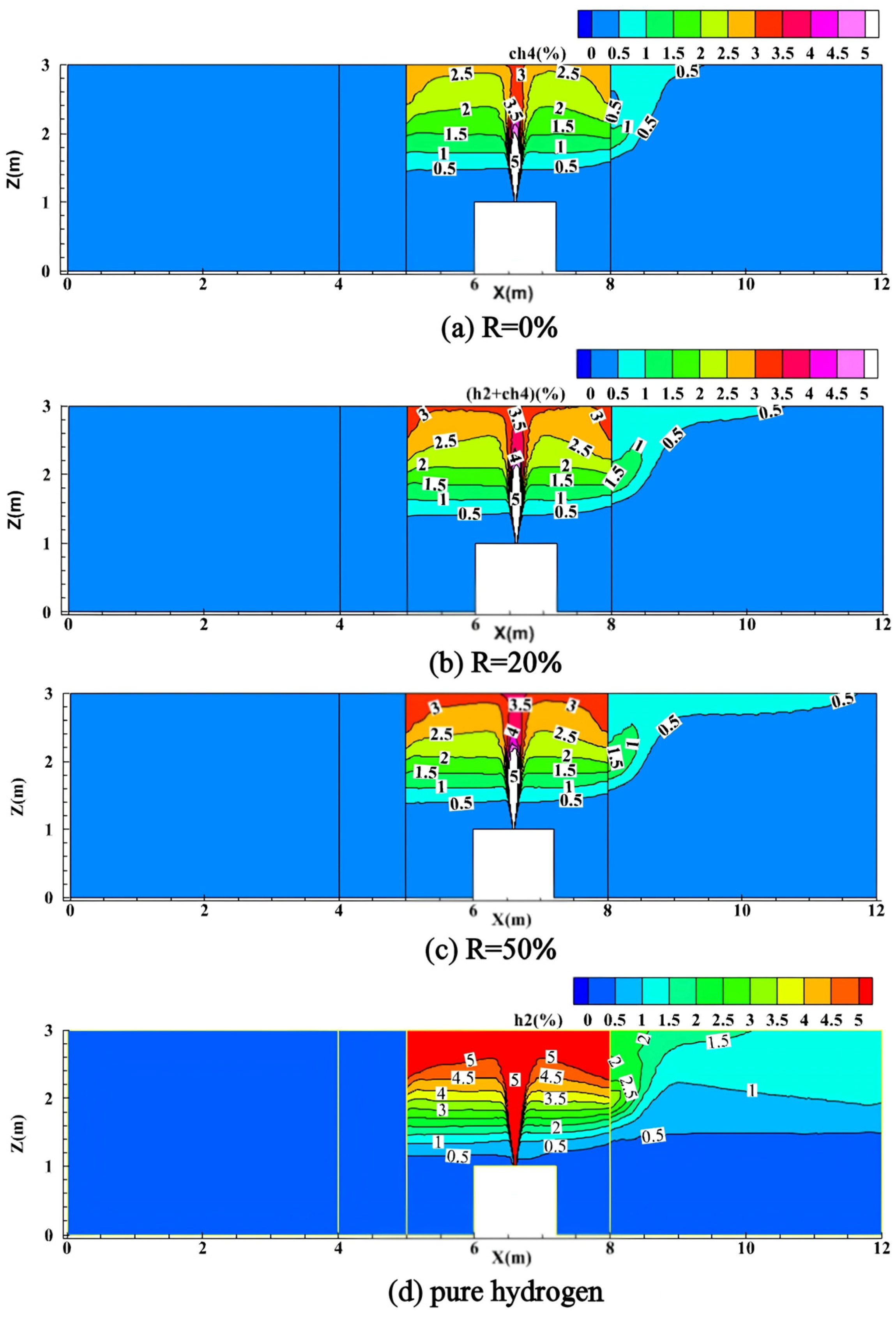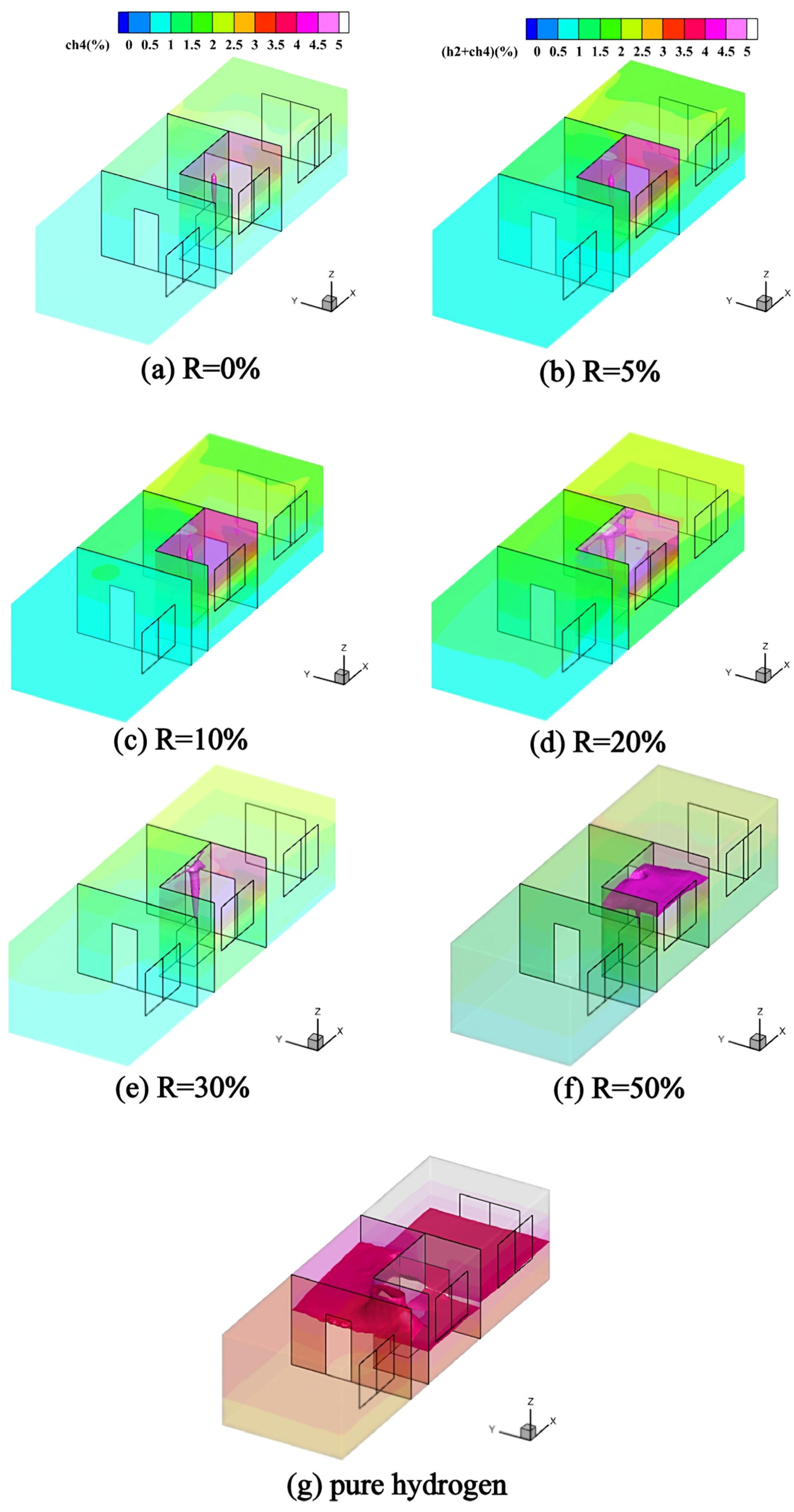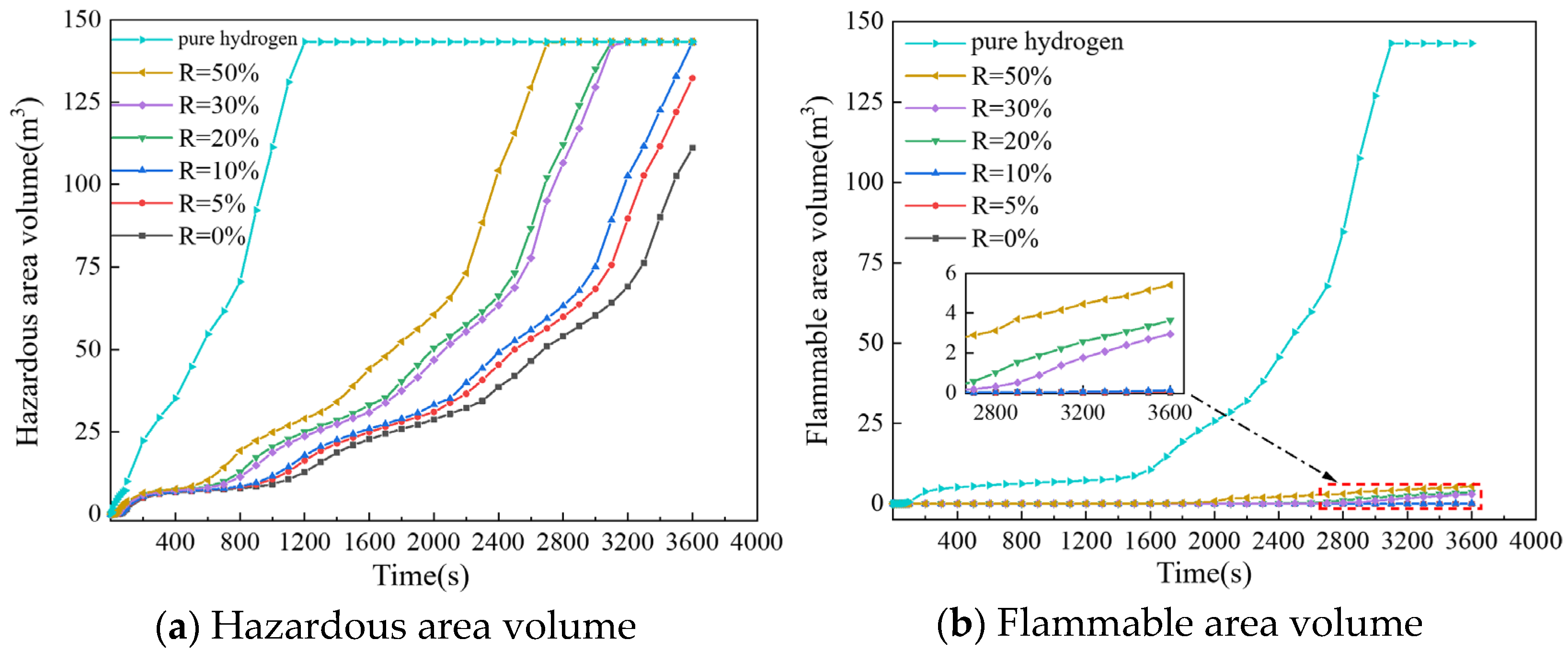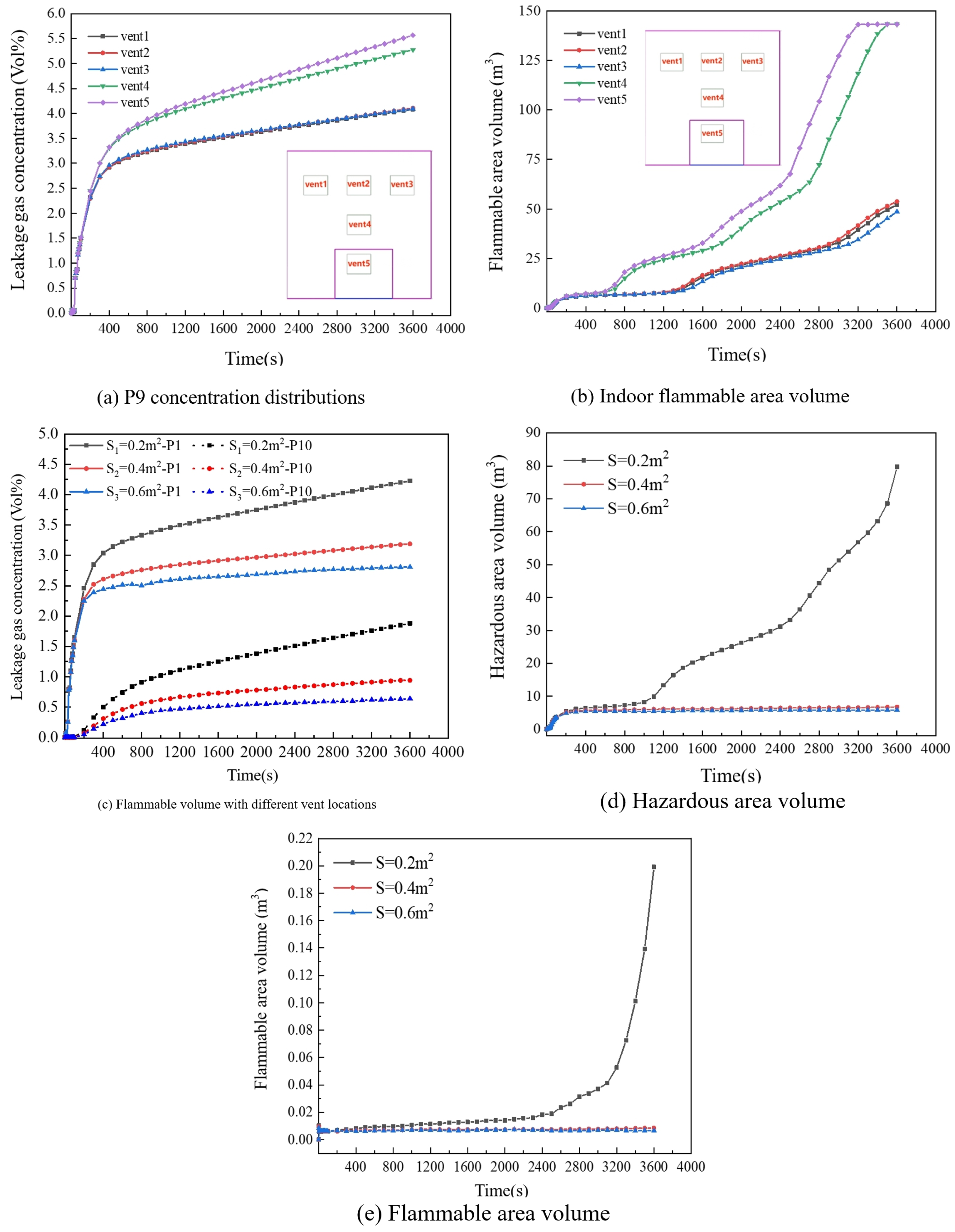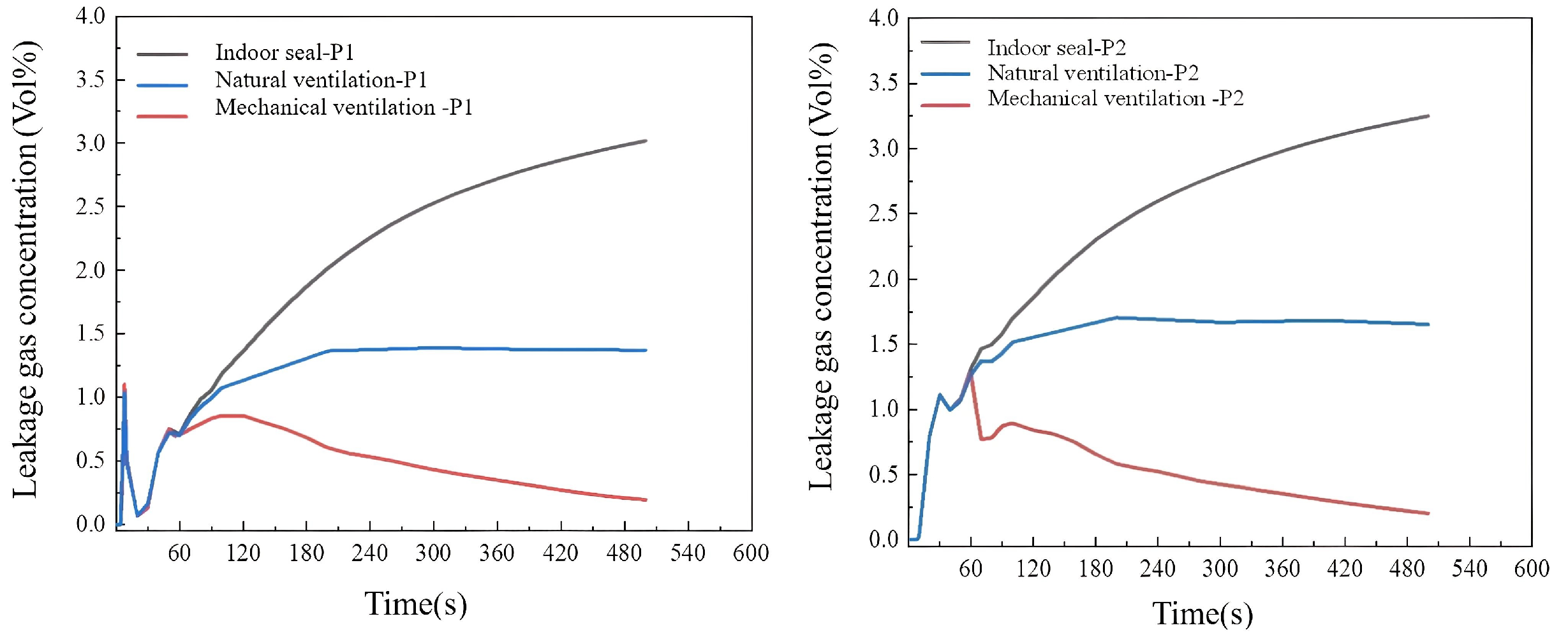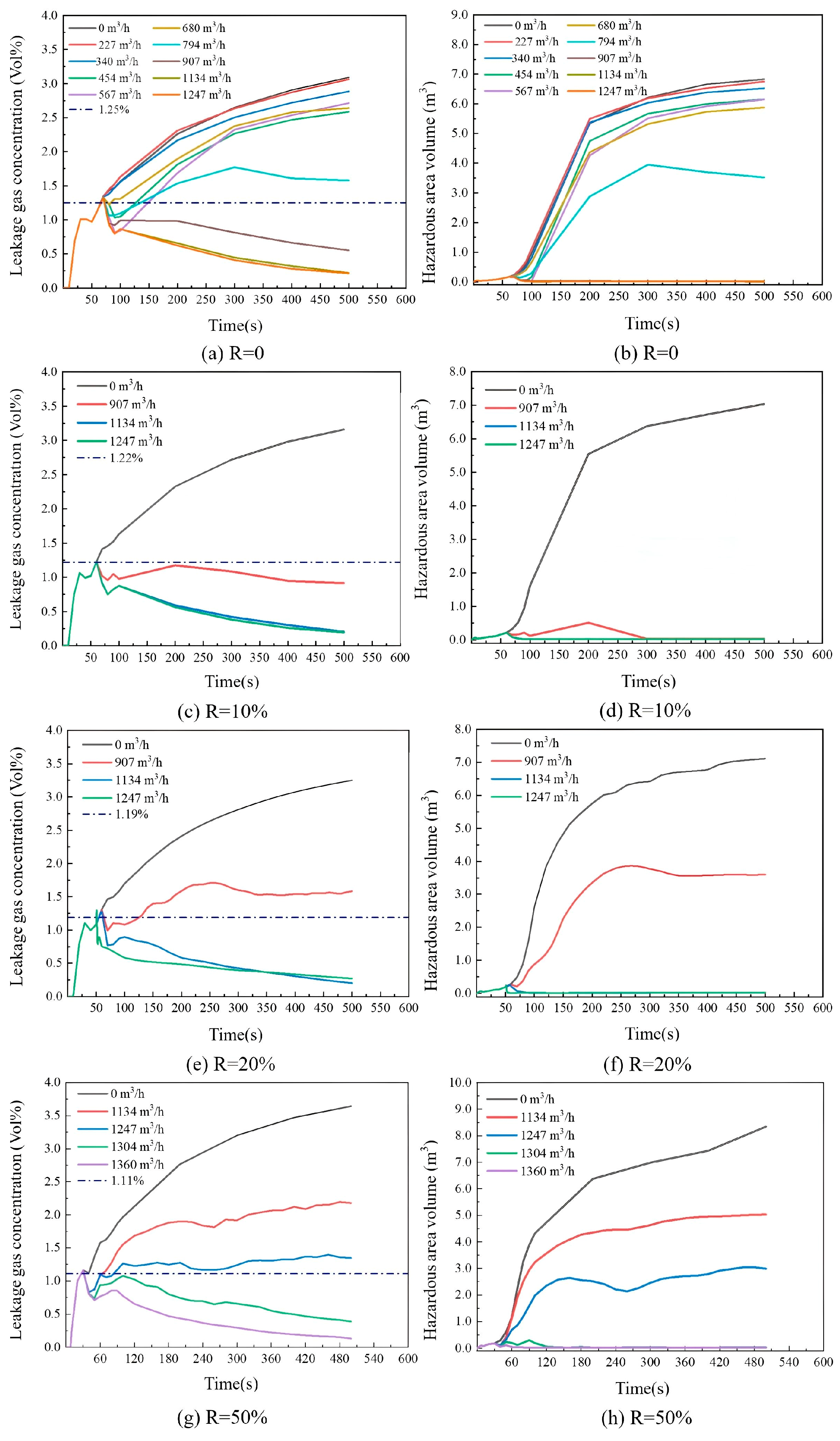1. Introduction
Driven by the global carbon neutrality agenda [
1,
2], Hydrogen is globally regarded as one of the most promising energy carriers due to its clean combustion [
3,
4], high efficiency [
5], zero-carbon emissions [
6], and abundant availability [
7]. Currently, the predominant methods for hydrogen transportation include liquid hydrogen tank trucks [
8], high-pressure hydrogen cylinder tube trailers [
9], and liquid hydrogen barges [
10,
11]. However, these approaches are limited by low transportation efficiency and high costs [
12]. An emerging alternative is blending hydrogen into natural gas pipelines for downstream utilization, which presents a novel pathway for hydrogen energy deployment [
13,
14,
15,
16,
17].
The global deployment of HBNG projects has grown substantially in recent years [
18,
19,
20]. Notable examples include France’s 2014 GRHYD project, which successfully demonstrated the technical feasibility of HBNG pipeline transportation [
21]. In 2019, the UK’s HyDeploy project confirmed the viability of blending hydrogen into natural gas pipelines at a 20% volumetric ratio [
22]. The same year, China’s Liaoning Chaoyang HBNG demonstration project successfully applied HBNG for residential energy supply [
23]. In 2021, the United States launched its largest HBNG project, “HyBlend,” aiming to achieve fuel decarbonization [
24]. These projects collectively focus on two key aspects: (1) the adaptability of existing natural gas infrastructure for hydrogen transport and (2) end-use equipment compatibility with HBNG [
25].
Compared to natural gas, hydrogen demonstrates significantly higher flammability and explosiveness, characterized by a broader flammability range [
26], greater diffusivity [
27], and lower minimum ignition energy [
28]. These properties render HBNG more susceptible to deflagration and other hazardous scenarios compared to natural gas [
29]. Furthermore, hydrogen modifies the leakage behavior and diffusion characteristics of gas mixtures [
30], potentially exacerbating leakage and explosion risks in indoor gas applications [
31], thereby raising significant safety concerns. To address these risks, researchers worldwide have investigated gas leakage diffusion and explosion characteristics in confined spaces. For instance, Xing et al. [
32] performed explosion experiments with methane-air mixtures in a chamber, demonstrating that obstacles enhance explosion overpressure, with magnitude variations depending on ignition location. Brady et al. [
33] carried out hydrogen leakage diffusion and explosion experiments in a garage model, examining the effects of ventilation on hydrogen dispersion and catalytic ignition sources on explosion risks. Their findings indicated that catalytic ignition sources significantly increase hydrogen explosion risks while correctly matching ventilation with leakage rates and effectively mitigating explosion hazards. Marangon et al. [
34] experimentally studied leakage and diffusion of hydrogen-methane mixtures (10% and 30% hydrogen) in enclosed spaces, observing initially non-uniform concentration distributions that gradually homogenize over time. Hajji et al. [
35] focused on hydrogen leakage in residential garages, systematically analyzing ventilation effects on dispersion patterns and establishing fundamental characteristics of hydrogen diffusion in such environments.
The rapid development of computational fluid dynamics (CFD) has established numerical simulation as a powerful methodology for investigating gas leakage phenomena [
36]. This approach eliminates the safety concerns inherent in experimental studies while enabling comprehensive analysis of HBNG leakage and explosion characteristics across diverse conditions through parameter variation. Several studies have demonstrated the effectiveness of this approach. Su et al. [
37] developed a household kitchen model using Fluent R19.2 to evaluate how various factors influence HBNG concentration distribution, explosion risks, and alarm response times. Their simulations revealed that at constant leakage rates, increasing the HBR substantially reduces both the alarm response time and the time to reach the lower explosion limit, while mechanical ventilation effectively mitigates gas accumulation. Cen et al. [
38] employed Fluent to simulate indoor gas leakage and diffusion dynamics, ultimately determining the minimum required ventilation area for typical northeastern Chinese residential buildings. Li et al. [
39] created a sealed container model using CFD to analyze leakage patterns, diffusion behavior, and flammable zone distribution for natural gas with varying HBRs. Their results indicated that at HBRs below 20%, HBNG exhibits leakage and diffusion characteristics comparable to pure methane. Lu et al. [
40] utilized the FLACS 9.0 to investigate how horizontal baffles at ventilation openings affect hydrogen concentration and ventilation efficiency. Their findings demonstrated that strategically placed baffles at ventilation inlets and outlets enhance airflow velocity while reducing interior hydrogen concentrations. The study further identified an optimal baffle height corresponding to peak ventilation efficiency.
The rapid advancement of the hydrogen energy industry has conclusively demonstrated the technical feasibility of HBNG. In the near future, hydrogen is anticipated to be delivered to residential consumers primarily through HBNG, with its main end-use application being indoor combustion for energy supply [
41]. However, current research exhibits two significant gaps: (1) limited consideration of varying HBRs as leakage sources and (2) insufficient focus on indoor environments as the study setting. Both experimental and numerical investigations of HBNG leakage and diffusion in indoor spaces remain notably scarce. To address these research gaps, the present study systematically examines HBNG leakage diffusion characteristics and associated safety risks in indoor environments. A numerical model of a representative indoor space is developed and experimentally validated to ensure reliability. The investigation focuses on three critical aspects: (1) the influence of HBR variations, (2) ventilation effects on leakage and diffusion patterns, and (3) the consequent impacts on indoor safety. Furthermore, the ventilation rate to ensure indoor safety is proposed.
5. Results and Discussion
5.1. The Concentration Distribution of HBNG
Condition 1 from
Table 3 serves as an example to analyze the effect of HBR on the concentration diffusion of HBNG.
Figure 6 presents the diffusion contours of different HBRs in indoor spaces at 300 s after leakage. The 3–4% gas concentration region is predominantly located above the leakage source. As HBR increases, the 3–4% concentration region expands along the ceiling, exhibiting a downward diffusion trend. A comparison between
Figure 6a,g reveals that the hazardous area and the flammable concentration coverage area of HBNG are significantly larger than those of natural gas. These results demonstrate that increasing the HBR elevates the risk associated with HBNG leakage.
The gas concentration distribution following HBNG leakage in indoor spaces is illustrated by a vertical slice along the X-Z plane at the leakage source, as shown in
Figure 7. The leakage process for different HBRs exhibits a confined jet diffusion pattern, with gas concentration above the leakage source being higher than in other regions. The maximum concentrations for 0%, 20%, 50% HBR, and pure hydrogen are 2.5%, 3.5%, 3.5%, and 5.0%, respectively, whereas the corresponding concentrations in Room 2 measure 1%, 1.5%, 2%, and 3%.
As HBR increases, the concentration stratification gradually diminishes. Vertically, the gas concentration rises with indoor height, exhibiting a distinct stratification effect. Horizontally, the gas concentration decreases with distance from the leakage source, with higher concentrations observed near the walls adjacent to the leakage source compared to the central region. The maximum diffusion distance for HBR of 0%, 20%, 50%, and pure hydrogen are 2.4 m, 4 m, 5 m, and 5.4 m.
The results presented in
Figure 7c,d demonstrate that increasing HBR leads to significant expansion of the hazardous area where the concentration exceeds the alarm threshold (25% LEL). At R = 50% and pure hydrogen, the concentration reaches the lower explosion limit (LEL) within 300 s after leakage. Furthermore, in the kitchen, a flammable region (gas concentration ≥ LEL) forms at elevations above 2.0 m, indicating that elevated HBR levels substantially enhance the leakage and diffusion risks of HBNG in confined spaces.
To further examine the influence of time on the leakage and diffusion process,
Figure 8 displays the distribution of the flammable region for HBNG at 2400 s. Over time, the indoor flammable region (indicated by red-purple areas in the figure) gradually expands beyond the kitchen into adjacent spaces. For 0–50% HBR, the flammable region remains predominantly confined within the kitchen. In contrast, the flammable region for pure hydrogen exhibits substantial expansion, encompassing most of the kitchen, Room 2, and the corridor. These results demonstrate that as HBR increases, the flammable region following leakage enlarges, resulting in a greater risk of gas leakage hazards in indoor spaces. Notably, R ≥ 50% presents a significantly elevated safety risk.
Figure 9 illustrates the variations in hazardous areas and LEL volume within confined indoor spaces under different HBRs of HBNG. As depicted in
Figure 9a, increasing the HBR leads to a gradual reduction in the duration during which the entire indoor space remains classified as hazardous. At R = 50%, the hazardous condition persists for 2700 s, while for pure hydrogen, this duration decreases to 1200 s, corresponding to a 55.6% reduction.
As shown in
Figure 9b, for R < 20%, the difference in the indoor flammable region compared to pure natural gas leakage remains negligible. However, when R ≥ 20%, the volume of the flammable region increases substantially. The most pronounced effect occurs with pure hydrogen, where the time required for the entire indoor space to become a fully flammable region decreases significantly.
5.2. Influence of Ventilation Location and Area on Diffusion Characteristics
To investigate the influence of different positions of ventilation openings located on the exterior wall near kitchen windows on ventilation effectiveness.
Figure 10a depicts the variation in gas concentration at P9 (6.5, 0.9, 2.7) for different natural ventilation opening positions. Altering the horizontal position of the ventilation openings (vent 1, 2, 3; area 0.2 m
2) results in gas concentration curves that follow a similar temporal trend and nearly coincide. At 3600 s, the gas concentration reaches 84% of LEL, substantially exceeding the gas alarm threshold. In contrast, adjusting the vertical height of the ventilation openings (vent 2, 4, 5) reveals that the concentration at vent 2 remains consistently below the LEL. However, at vent 4 and vent 5, the concentration surpasses the LEL at approximately 2500 s.
Figure 10b presents the variation in flammable region volume for different ventilation positions. The flammable region volume gradually increases when the ventilation openings are set at positions 2, 4, and 5.
Figure 10c presents the concentration variations at P1 (kitchen) and P10 (room 2) under different ventilation opening areas at R = 50%. At 3600 s, the gas concentration at P1 decreases by 24.58% and 44.6% for opening areas of 0.4 m
2 and 0.6 m
2, respectively. This indicates a negative correlation between indoor gas concentration and ventilation opening area, with gas concentration gradually decreasing as the ventilation area increases. However, the marginal benefit of increasing the ventilation area diminishes beyond a certain threshold. While greater ventilation areas accelerate the establishment of indoor-outdoor airflow equilibrium, merely expanding the opening size proves insufficient for maintaining gas concentrations below the alarm threshold throughout the entire indoor space.
Figure 10d,e illustrates the variations in the hazardous area and flammable gas volume for different ventilation areas at R = 50%. Increasing the ventilation area from the initial 0.2 m
2 to 0.4 m
2 and 0.6 m
2 reduces the hazardous area and flammable gas volume by 91.51%, 92.67%, 95.73%, and 96.74%, respectively. Additionally, the indoor flammable gas region is almost completely eliminated. Altering the ventilation position yields a maximum reduction of 66.65% in the hazardous gas region volume. In comparison, modifying the ventilation opening area achieves a maximum reduction of 92.67%. These results demonstrate that the ventilation area significantly influences gas concentration and flammable region distribution.
Figure 11 demonstrates that the concentration contour exceeds the alarm threshold under fixed ventilation conditions (Vent 2 position, 0.2 m
2 area) for different HBRs in HBNG (
Red Zone: An area where the gas cloud concentration exceeds the alarm threshold (1.11%)). The results indicate that when the ventilation position and area remain constant, the spatial extent of concentrations exceeding the alarm threshold decreases as HBR increases, following the order: pure hydrogen > 50% > 20% > 0%. The hazardous area volume with HBR of 20%, 50%, and pure hydrogen increased by 1.89, 2.65, and 5.04 times, respectively, compared to natural gas. This demonstrates that HBR higher, the indoor safety risk greater.
It is recommended that indoor spaces utilizing HBNG adopt optimized ventilation strategies, including increased opening areas and elevated vent placement. This approach capitalizes on hydrogen’s buoyancy to enhance safety without substantially increasing construction costs.
5.3. Influence of Ventilation Method on Diffusion Characteristics
The effects of natural ventilation and mechanical ventilation (ventilation rate: 1134 m
3/h) on HBNG leakage and diffusion are analyzed in
Figure 12, which shows the concentration variations over time at P1 (6.5, 0.9, 2.7) and P2 (7, 1.75, 2.7) under different ventilation conditions at R = 20%. P2 corresponds to the designated installation location of the indoor gas alarm. Mechanical ventilation initiates automatically when the gas concentration at P2 reaches the alarm threshold.
In sealed conditions, the gas concentration exhibits a gradual increase following an HBNG leakage event. Under natural ventilation (ventilation area: 1.34 m2), the indoor gas concentration initially rises before stabilizing, yet remains above the alarm threshold. By contrast, when mechanical ventilation is activated, the gas concentration at all monitoring points decreases below the alarm threshold within 60 s.
Figure 13a,b,h presents the hazardous area variation at R = 20% and 400 s under different ventilation conditions. The results demonstrate that the hazardous area volume reaches its maximum in enclosed indoor spaces and its minimum under mechanical ventilation. Compared to enclosed indoor conditions, natural ventilation reduces the hazardous area volume by 53.29%, while mechanical ventilation achieves a 99.76% reduction.
Consequently, automatic mechanical ventilation systems interlocked with gas detectors should be required as a core component of the safety standard for homes using HBNG. Mandating these systems in all new construction and retrofit projects must be considered by policymakers, drawing a parallel to existing commercial kitchen regulations, to ensure rapid hazard response.
5.4. Determination of Safety Ventilation Rate
To examine the impact of ventilation rate during continuous leakage,
Figure 13c–f,h displays the volume contour of hazardous areas at various time intervals under a ventilation rate of 1304 m
3/h with R = 50%. The results indicate that the hazardous area volume progressively increases from 10 s to 30 s, peaking at 30 s when P2 attains the alarm concentration. Following the activation of mechanical ventilation, the hazardous area within the indoor space diminishes gradually over time. By the 240 s, the hazardous area has persisted solely above the leakage source.
To further determine the safe ventilation rate—defined as the rate at which the indoor gas concentration remains consistently below the alarm threshold while nearly eliminating the flammable region—for different HBRs leakage scenarios, the safety criterion is established based on the P2 concentration being lower than the alarm threshold (
Table 3).
Figure 14 presents the variations in P2 concentration and the corresponding changes in indoor hazardous areas. Analysis of
Figure 14a,b demonstrates that a ventilation rate of 907 m
3/h maintains safe conditions for natural gas leakage. Similarly,
Figure 14c,d confirm that 907 m
3/h also constitutes a safe ventilation rate for R = 10%. However,
Figure 14e,f reveal that a higher ventilation rate of 1134 m
3/h is required for R = 20%, while
Figure 14g,h indicate that 1304 m
3/h is necessary to ensure safety at R = 50%.
The variation patterns of leakage concentration and hazardous areas for different HBRs exhibit trends similar to those of natural gas as ventilation rates change. When HBR is constant, indoor gas concentration and hazardous areas decrease with increasing ventilation rate. However, further increases in ventilation yield diminishing reductions in indoor gas concentration once the ventilation rate reaches a level commensurate with the indoor space volume. When the ventilation rate remains constant, higher HBRs lead to gradual increases in indoor gas concentration and hazardous areas. Additionally, the alarm response time at P2 advances, with response times for 10%, 20%, and 50% HBRs occurring 9.1%, 24.24%, and 59.1% earlier than that of natural gas. The safe ventilation rates for different HBRs are presented in
Table 7. We emphasize that the safe ventilation rate was obtained within the context of our model, and the proposed methodology is meant to guide its determination.
